King's Cup - 1929
-
Jackaman, Alfred Charles Morris
Mr Alfred Charles Morris Jackaman 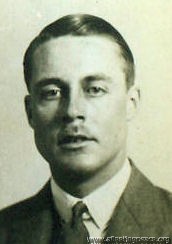 1927, aged 23
1927, aged 23A civil engineer from Slough; in 1936 he and Marcel Desoutter decided that an airport at Gatwick might be a nice idea (it was, after all, "outside the London fog area").
He later married Australian-born Muriel Nora 'Cherry' Davies and they ended up near Sydney; he died in 1980, but she survived until 2011 - aged 101. see
http://www.smh.com.au/national/obituaries/love-and-duty-shaped-long-life-20110923-1kp9i.html -
Jackson, R W
F/O R W Jackson Later a Wing-Commander;
Wing Commander R. W. Jackson (R.A.F.), Albert Street, Castleton. January, 1945. New Year's Honours List 1945. Twice mentioned in despatches, and given the Air Efficiency Award in 1944.
"TECHNICAL BRANCH.
Promotion. Notification cancelled. 13th Sept. 1949 '(p. 4395, col. 2) concerning
R. W. JACKSON, O.B.E., A.M.I.Mech.E., A.iR.Ae.S.(70343)."
-
Kimmins, A M
Flt-Lt A M Kimmins ?? -
Law, Harrington Robley
Mr Harrington Robley Law 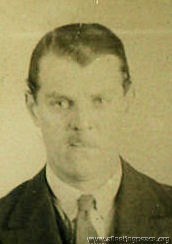 1928, aged 29
1928, aged 29Originally from Scotland; son of Bonar Law. In 1939 a member of the Insurance Flying Club.
Apparently he had a lisp, but was very able.
-
Leech, Haliburton Hume
P/O (later F/O, Flt Lt) Haliburton Hume Leech 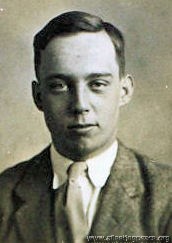
photo: 1926, aged 18
Haliburton H Leech was born 16 Apr 1908, in Wylam-on-Tyne, Northumberland. He competed in 6 King’s Cup races – every year from 1929 to 1934.
His father, Dr. (later Sir) Joseph William Leech, J. P., was the Sheriff of Newcastle-upon-Tyne, and later its M.P.; at the time they lived in Wylam Hall, which according to English Heritage is a vast “rambling house built in the 15th century with 18th-19th century alterations, since divided into 3 apartments”. Haliburton was the youngest of 3 sons.
He went to Harrow from 1922 to 1925, then gained his Royal Aero Club Certificate (No 7993) at Cramlington with the Newcastle-on-Tyne Aero Club, flying a D.H. Moth, on the 10 Apr 1926.
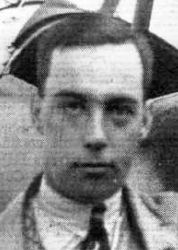
In 1931, Flight described him thus:
“… a well-known figure at flying meetings, as his aerobatic demonstrations in the Martlet are always amongst the prettiest to be seen.
He entered Cranwell as a cadet in 1925, finally leaving there and being posted to Tangmere in 1927.
He was promoted to Flying Officer in July 1929, and in 1930 went to the Royal Aircraft Establishment at Farnborough, and has since been engaged on a great deal of test work, flying a large variety of machines.
This year he was selected as one of the members to join the High Speed Flight at Felixstowe preparatory to receiving his training to take part in the forthcoming Schneider Trophy Race, but, much to his disappointment, he was later sent back to Farnborough, as it was found that there were too many pilots in the flight.
F/O. Leech has raced on numerous occasions in light aircraft, and is always consistent.”
However, during one such aerobatic demonstration, one cynic pointed out that "After all it does not matter if he does crash, as his father is a doctor!”
In 1932, he piloted the Royal Aircraft Establishment’s Scarab (a parasol-wing modification of the D.H. 53 Humming Bird) on its first flight.He was posted to the School of Naval Co-operation, Lee-on-the-Solent, on the 1st March 1934, then (as a Flight Lieutentant) to No. 824 (F.S.R.) Squadron, Upavon, on the 8th October 1934.
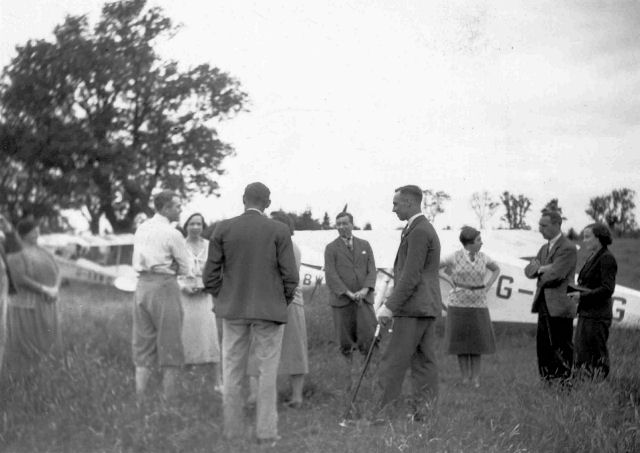
Here he is (with a bandaged left hand) with Leslie Runciman, 'C.C', and Connie Leathart, amongst others He was best man at his elder brother Basil's wedding to Grace Luckham in September 1937, then married Miss Ruth Janet Chernocke Elliott (the younger daughter of Mr and Mrs A E Elliott of Little Hill, Bromeswell, Woodbridge) at Eyke Church, Suffolk on 9th October 1937. The happy couple then left by air, from Martlesham, 'for abroad'.
He died 5th May 1939, in St Bartholomews Hospital, when he was only 31 - I don't know why, I'm afraid. Perhaps it was as a result of a flying accident, or perhaps natural causes. Unusually, 'Flight Magazine', who carried innumerable references to his flying displays, carried no news of his death - normally they would have produced a short obituary of someone so well-known in aviation circles.
His gravestone (with thanks to the Gravestone Photographic Resource) is in Eyke Church:
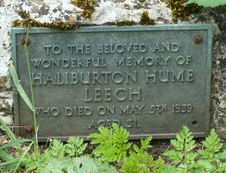 "To the beloved and wonderful memory of Haliburton Hume Leech".
"To the beloved and wonderful memory of Haliburton Hume Leech".His father, Sir Joseph, died a year later.
Ruth married a Mr Foster in 1940 and died in 1986 in Ipswich; she was referred to as 'Ruth Janet C Lady Foster'.
He competed in loads of air pageants and races throughout the 30s, including:
- The Kingston-upon-Hull Air Race, at the Hull Air Pageant which was held to celebrate the opening of the Hull Aero Club clubhouse in April 1930.
The 7 entrants were Leech (flying "Miss Perry's D.H. Moth G-AASG" *); Winnie Brown flying her Avian G-EBVZ; Winifred Spooner in her D.H. Moth G-AALK; Ivor Thompson (D.H. Moth G-AACL); Alfred Jackaman (D.H. Moth G-AADX); Robert Cazalet in his Westland Widgeon G-EBRM, and Capt G Thorne in Avro Avian G-AAHJ.
Leech finished first but was disqualified for ‘not turning at one of the marks’.
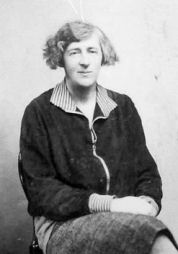
* Miss Violet Perry (seen here), who flew at the Berks Bucks and Oxon Club, is not listed as the owner of G-AASG, though; it apparently belonged to 'Miss M Shillington'.
September 25, 1932 saw him coming 3rd in the Yorkshire Trophy Race - "175 and a half miles over two triangular circuits" in the Arrow Active, behind Edgar Percival in a Gull, and Col. Louis Arbon Strange in his Spartan.
Later, "F/O. Leech gave one of his thrilling, if not hair-raising, displays on the Arrow Active."
In July 1933 he was in the Cinque Ports Wakelfield Cup Race; coming 3rd in a Pobjoy-engined Comper Swift.A few weeks later (12 August 1933), he put up the fastest time in the London to Newcastle Race in Richard Shuttleworth's Gypsy-engined Comper Swift G-ABWW, but ended up 5th (of 10) on handicap. He received a cheque for £10 for his effort; the 166.09 mph was "the highest registered speed obtained on any British light aircraft" at the time.
In July 1937, he was one of 15 competitors in the Devon Air Race (which also included Alex Henshaw, Connie Leathart, Tommy Rose and Geoffrey de Havilland). He came 3rd, in a Spartan Arrow.
In the King’s Cup:
1 - G-EAUM (1929)
This aircraft was a real-old-timer, an Avro 534 ‘Baby’, first registered in July 1920. Squadron Leader Harold Payn had raced it in 1922, and R. A. Whitehead (who sold it to Leech) in 1928. Leech, in turn, sold the aircraft to H.R.A. Edwards, and it was finally withdrawn from use in November 1934.
2 - G-AALK (1930)
This D.H.60G Gipsy Moth was almost new (first registered August 1929), and belonged to the Household Brigade Flying Club at Hanworth. It was flown by Squadron Leader the Hon. Frederick E Guest in the 1931 race, then went to Wrightson Air Hire, but crashed at Shackend Railway Station near Hawick in April 1937.
3 - G-ABIF (1931)
This Southern Martlet 205 had only been registered in January 1931, and belonged to Miss J Forbes-Robinson. Theodore C Sanders flew it in the 1933 King’s Cup race. It was withdrawn from use in 1940, but went to the ATC during WWII, until it was finally cancelled in December 1945.
4 - G-ABVE (1932, 1933)
G-ABVE was the only Arrow Active II ever built, registered in March 1932 to Arrow Aircraft Ltd of Yeading, Leeds. Leech flew this aircraft in the 1932 and 1933 races, achieving 137mph.
In an extraordinary link with MacRobertson aviator Geoffrey Shaw, they were together in July, 1932:
"Six members joined the Yorkshire Aeroplane Club during June, amongst them being Mr. Geoffrey Shaw and Mr. A. C. Thornton. The latter is the designer of the" Arrow Active," and his latest production, the "Active II" has been much in evidence, being tested by F/O.H. H. Leech."
After the race, it was stored at Yeading until 1957 before being completely renovated in 1958, with the installation of a 145-hp Gipsy Major engine. It survives, and is now in the Real Aeroplane Collection at Breighton Aerodrome, Selby, Yorks.
5 - G-ACUP (1934)
Unfortunately, the registration of this brand-new Percival D.3 ‘Gull Six’ did not prove prophetic; Leech only managed fifth in the heats, despite averaging 160mph. The Gull went on to re-appear in the Kings’ Cup in 1938, flown by H Thomas-Ferrand, and was then sold in Australia in May 1939.
-
Manning, Edye Rolleston
Mr Edye Rolleston Manning 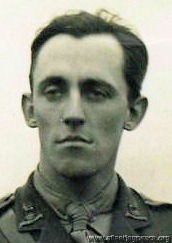 1916, when a Lieut, 15th Hussars, aged 27
1916, when a Lieut, 15th Hussars, aged 27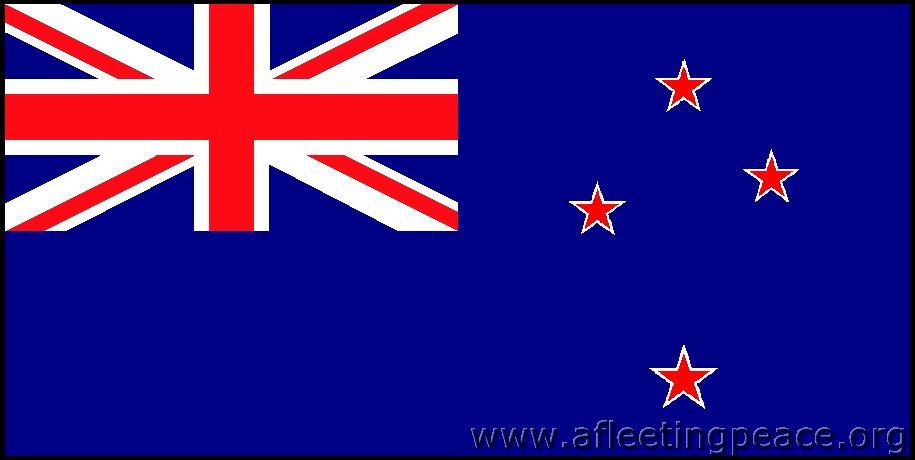 b. Sydney, NSW; wounded during the Battle of the Somme.
b. Sydney, NSW; wounded during the Battle of the Somme.Later Air Commodore; died 1957
-
Napier, Carill Stanley
Mr Carill Stanley Napier 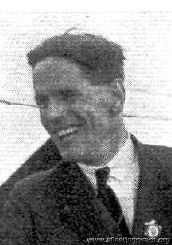 1937, aged 30
1937, aged 30b. 29 Apr 1907 From Putney, London
Son of the famous engine-maker Montague; an apprentice with Westlands in 1929. 'his one recreation apart from flying is the commendable indoor sport of darts. Believes that air-racing is good fun only when taken not too seriously''
Killed in WWII: 29 April 1941, when a First Officer in the Air Transport Auxiliary; buried RAF Halton, Bucks.
see https://www.ata-ferry-pilots.org/index.php/category-blog-1939/53-napier-carill
-
Probyn, Harold Melsome
Wing-Cmdr Harold Melsome Probyn 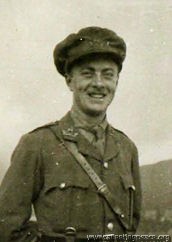 1916, when a 2nd Lieut in the 2/5th Royal Warwickshire Regiment, aged 25
1916, when a 2nd Lieut in the 2/5th Royal Warwickshire Regiment, aged 25from Lancashire, later an Air Commodore; retired to Kenya.
Felt that aviation wasn't as much fun after the invention of the parachute.
In 1927-8 he entered as 'Harold Brooklyn', and 1929-31 he entered as 'J Wellworth'; I have no idea why.
-
Richardson, Llewellyn George
Lieut Llewellyn George Richardson, RN 
photo: 1930
Royal Navy 1922-1951, but RAF 1925-36
-
Rose, Thomas
Flt-Lt Thomas 'Tommy' Rose DFC 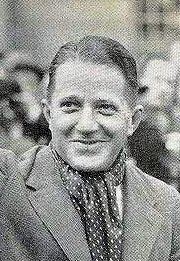 1936
1936b. 27 Jan 1895 - Alton, Hants
One of the best-known racing and pioneering pilots of the 30s.
His father, John, was a farm bailiff at Basing Farm, Froxfield, nr Petersfield, Hants. After working briefly as a bank clerk, Tommy joined the Royal Navy in 1914 and then transferred to the R.F.C. in June 1917.
"He was shot down three times, but escaped each time. He was awarded the DFC for his work with the fighter squadron in which Billy Bishop, VC, served. "
m. 1925 Margaret Elizabeth [Ashford], [divorced 1938]
Retired from the RAF in 1926 with the rank of Flight-Lieutenant.
In December 1931, he made an unsuccessful attempt on the UK-Cape record, and then flew back "by easy stages".
From Oct 1933, Manager and Chief Instructor at Sywell.
"TOMMY ROSE is gone from Sywell, but not forgotten. As sales manager for Messrs. Phillips and Powis, the Reading aircraft manufacturers, he spends quite a lot of time flying round the country. Last week his photograph was 'splashed' in all the national daily papers, greeting Mr. H. L. Brook, the Yorkshireman airman, on his arrival at Croydon after breaking the Australia-England record previously held by Jim Mollison. There was no mistaking Tommy’s famous sports jacket and boyish grin!
Mr. Rose, the way, left a last impression at Sywell. Shortly before leaving, when the new gate was being erected in front of the clubhouse, he carefully placed his foot in the wet cement and printed beside it 'Tom Rose' with a trowel. The cement hardened, and the 'Rose' mark is there for posterity to reverence! Hundreds of feet have since trod the hallowed spot." - Northampton Mercury, 12 April 1935
Competed in the King's Cup six times, winning it in 1935...
![Kings Cup 1938 Tommy Rose [0122-0170]](/images/gallery/air%20races/preview/333s333/Kings%20Cup%201938%20Tommy%20Rose%20%5B0122-0170%5D.jpg)
© The Royal Aero Club [0122-0170]
... and coming second in 1934 and 1936.
[The 1935 King's Cup itself recently sold at auction for £3,900:

Photo kindly supplied by Sarah Chambers, reproduced by kind permission of Sworders Fine Art Auctioneers.]
He became a national hero in March 1936 after his flight to Cape Town and back; "he can now claim to have made the fastest time for the trip both out and home. His new record is 6 days 6 hr. 57 min. (he got to the Cape in 89 hr. 37 min.), which beats F/O David Llewellyn's time—the previous best—by 5 hr. 6 min."
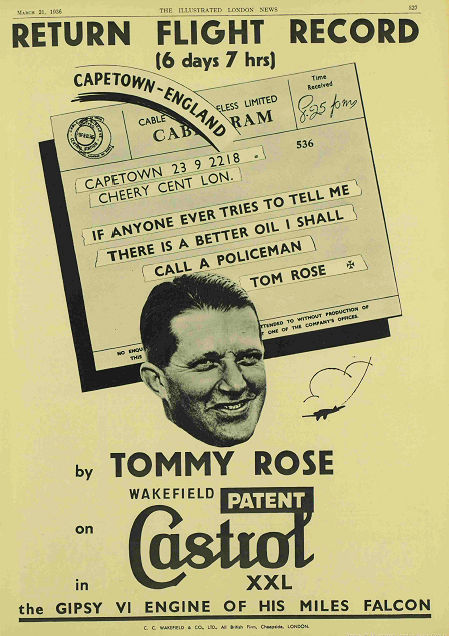
After the flight to the Cape, he had tea with the Prime Minister, General Hcrtzog, and also saw General Smuts. However, he was charmingly modest about his achievements:
"TOMMY ROSE ON LONG FLIGHTS
SAYS RECORD ATTEMPTS ARE 'LARGELY BUNKUM'
This flight business is bunkum! The authority for that picturesquely phrased piece of information is Flight- Lieutenant Tommy Rose, and he should know, for he hit the headlines in all the national newspapers when he smashed all records for the flight from London to the Cape. In a talk to the Round Table at Stewart's Cafe on Monday he summed up the whole business in these few words: 'All long distance flights are largely bunkum. The national newspapers, if there is no other news at the time, whip up an interest in these flights, and if one gets there safely and breaks a record everyone thinks: 'By gad, here's one of the twelve apostles come to life!’ (Laughter.)
'But I assure you there is nothing in it. The only things you have got do to be successful are to get the best machine you can find and then practise sitting still for a long, long time . . . . '
Reflections wise and witty on flying in general and his own flight in particular made Flight-Lieutenant Rose's talk one of the most delightful and amusing to which Tablers have listened to for a long time. His racy manner produced a laugh at almost every sentence, and a more unassuming world record breaker than this genial young man would be difficult to find.
There was one richly humorous story which is worth repeating. 'When I eventually got to the Cape I had to broadcast to the Union,' he said. 'The announcer seemed very nervous and this was what he said: ’Who do you think I have here the studio? None other than Mr Tom Mollison, who flew from London to the Cape in 37 days 18 hours.’ I met General Hertzog few days later and he said: 'if it takes all that time to fly, don't you think you had better come by boat next time?’
Flight-Lieutenant Rose answered a number of questions and urged the need for municipalities laying down landing grounds for aircraft. Members of the Rotary Club and of other Round Tables were present, as guests, to hear the airman’s talk. " - Eastbourne Gazette, 6 May 1936
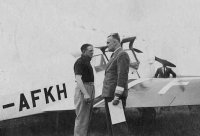
© The Royal Aero Club [0129-0039]
Before the 1936 Schlesinger Race to Johannesburg, he predicted: "It is my opinion that the pilot of the aeroplane which gets there in under forty-eight hours will deserve just about the biggest bunch of bananas ever found.
Having got lost myself many times down this route when flying without wireless, I fully expect to do so again, and the pilot in this race who can honestly say at the end that he was sure of his position all the time will either be very lucky, very clever, or have a queer idea of honesty."
From 1939 to 1946, Chief Test Pilot for Miles Aircraft, living in Sonning, Berks; in July 1943 he was reported to have "improved considerably and to be well on the way to recovery, after he contracted a chill when captaining his works cricket team. "
Won the Manx Air Derby in 1947, still flying a Miles Hawk; three circuits of the island at 181 mph.
d. 20 Jun 1968 - Alderney, Channel Islands.
-
Spooner, Winifred Evelyn
Miss Winifred Evelyn Spooner
Royal Aero Club Certificate No. 8137 (11 Aug 1927)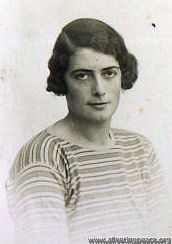 1927, aged 27
1927, aged 27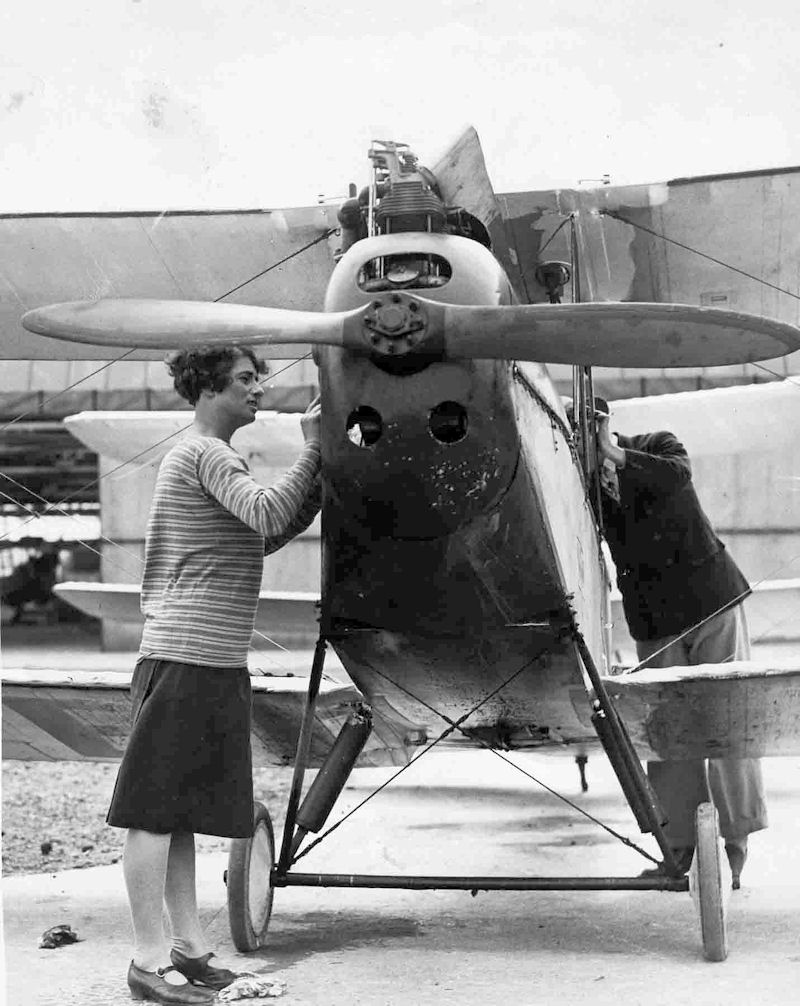
'Bad luck Wimpey' was one of the best-known women aviators of the time, and the one generally regarded as the best. She was awarded the International League of Aviation's Trophy for women aviators in 1929, and in 1930 Capt C D Barnard described her as 'the finest woman pilot in the world' (He went on to say that Lady Bailey was regarded as the 'second finest airwoman in the world', and we don't know what she thought about that...)
Learnt to fly in 1926 and took it 'more seriously than most' - in her first race in April 1928, she won the Suffolk Handicap (21 miles at 78mph), ahead of Neville Stack and four other male rivals; she won the 'heavy' category in the Round Europe Contest for Touring Aircraft in 1930 - covering 4,700 miles at 102mph, ("a very fine performance indeed", said The Times) and also competed in the Ladies event at Reading (May, 1931) - the other competitors were Amy Johnson, Grace Aitken, Pauline Gower, Dorothy Spicer, Susan Slade, Gabrielle Burr, Christina Young, and Fidelia Crossley - a historic gathering indeed.
Photo here
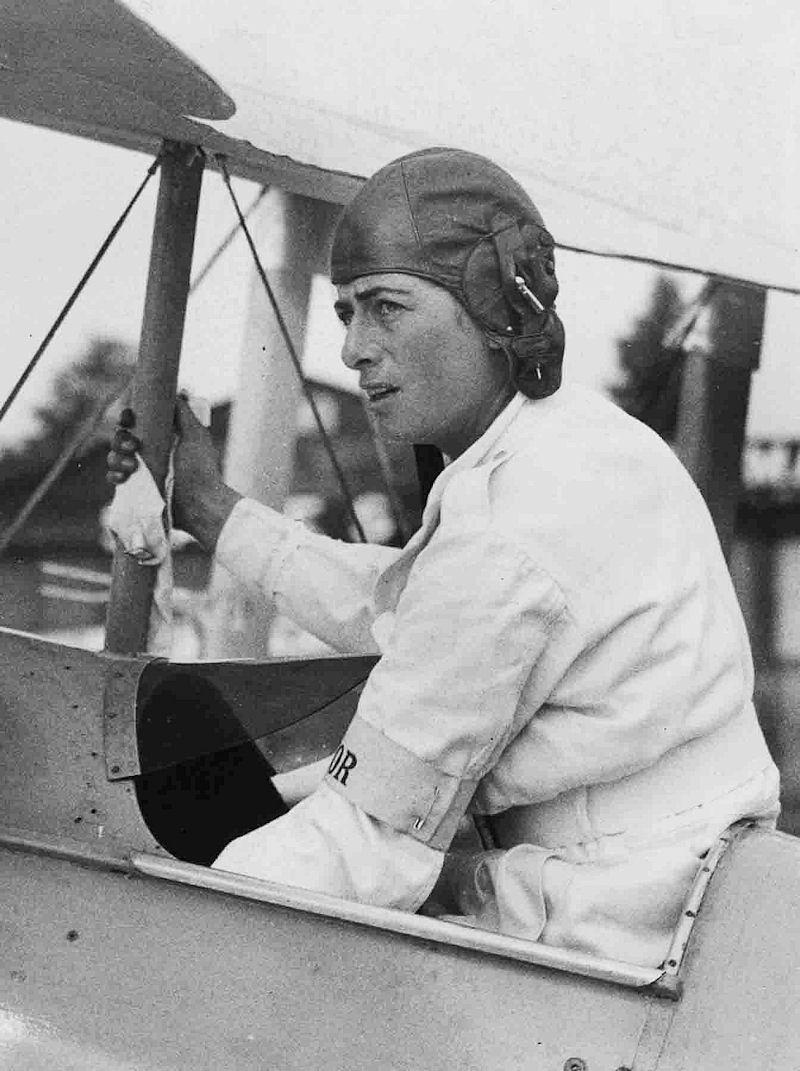
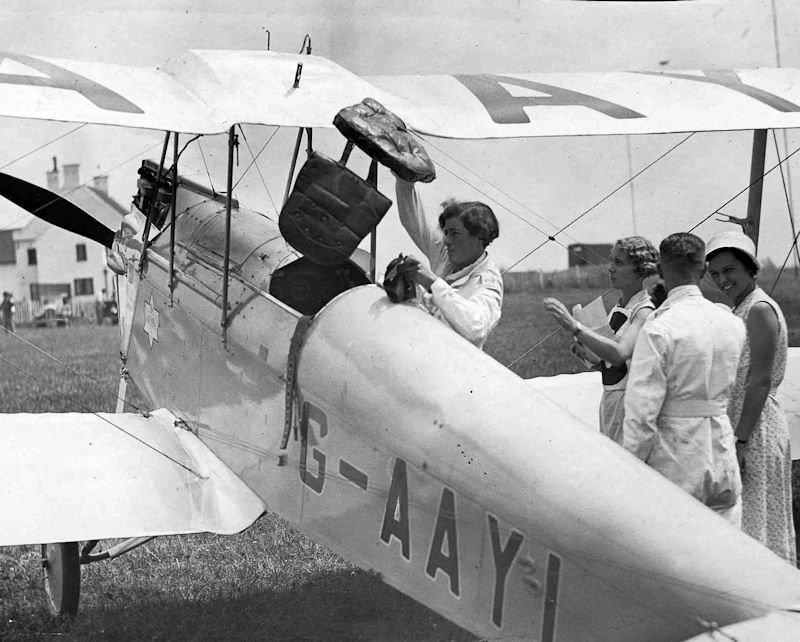
She soon took her 'B' (Commercial) Licence, and at one stage was the only professional woman pilot in the country.
In September 1927 her first flight abroad was to Venice to support the British Team in the Schneider Cup in Venice. Alan Butler (with Peter Hoare as passenger), and Hubert Broad, who took Maia Carberry, also went and, in case you were wondering, "Mrs. Carberry wore a pale blue leather flying helmet to match the colour of her Moth aeroplane."
She soon became regarded as 'one of the few women who matter in the air world'; in March 1928, when King Amanullah of Afghanistan was on a state visit to London, he inspected "the latest types of Imperial Airways passenger machines and a number of small Moth machines in private ownership. He carried on, through an interpreter, an animated conversation with Miss Winifred Brown, of Manchester, and Miss Spooner, of London, both of whom own and fly small two-seater machines."
In the 'Woman's World' section of the Inverness Courier of April 1928, this description of Winifred appeared: "[she] has not flown for very long, for it was only about three years ago that I knew her in Cologne, when she then drove, instead of an aeroplane, a two-seater car, through the crowded streets of Cologne, at a speed which most people would have been terrified to attempt. She was always, however, extremely cool and composed, and though her passengers were sometimes nervous she never seemed so. She was always very sporting, and played an excellent game of tennis. A good-looking, typically English girl, she made many friends among the British army in Cologne when doing voluntary work with the Y.M.C.A. there. [Winifred was with the 'Army of Occupation' in Germany at the time]"
She did have what she later described as her 'greatest air thrill' on Marlborough Common in May 1929; "she had been taking passengers up all day when, after one flight, she said she was not quite satisfied with the controls, and refused to take the next man until she had attended to the aeroplane. After doing so she started the propeller, and as she walked away from it the machine suddenly moved forward. Pluckily, Miss Spooner jumped and caught hold of the wing, her idea being to clamber into the cockpit and stop the engine. The machine quickly gathered speed, and she was dragged 40 or 50 yards [she later reckoned it was about 30 yards], when to the horror of the crowd the plane turned and buried its nose in the ground, hurling Miss Spooner some distance. She was unconscious. Doctors were sent for and she was taken to hospital. 'We thought she must have been killed,' an eye-witness told our representative."
She was taken to Savernake Hospital suffering from a sprained wrist, cuts, and slight concussion.
She does seem to have had quite a few run-ins with the local Constabulary; firstly in January 1929 for failing to keep her Alsatian dog under proper control (it had attacked another dog which "had no chance"), then in August 1929 for failing to produce a car driving licence (she said she had forgotten about it and flew to France the following day); then in 1931, she was fined £35 for leaving her motor car unattended and for failing to have lights on it. When she was told that she would be reported, she said: "I am used to it." A police-superintendent said there were no previous convictions recorded against her, as far as Reading was concerned. The Chairman then asked 'And none in the air? She replied 'There are no policemen in the air. That is why I like it.'"
I'm certainly sorry I missed her talk, given in April 1928 at Harrods in Brompton Road, on "Flying as a New Delight for Womankind". Later, in the early thirties, she wrote for "Good Housekeeping" on, of course, "Flying for Women", alongside such luminaries as John Galsworthy, Kate O'Brien, and Hugh Walpole.
.jpg)
September 1929 saw her accompanying NFS's chairman Freddie Guest (q.v.) to Nairobi, to inaugurate an air taxi service and give flying lessons. They took 3 aeroplanes with them, and flew them back (via South Africa) in February 1930.
She and E C T 'Cecil' Edwards tried to fly a Desoutter to Cape Town and back in December 1930, but this expedition ended up in a forced landing in the sea off southern Italy; Cecil and Winifred had to swim a couple of miles to shore.
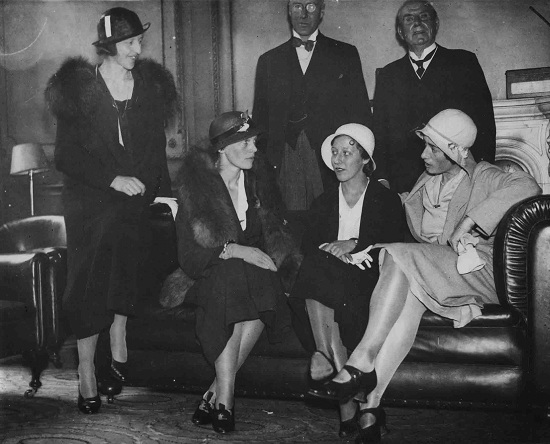
She regularly competed in the King's Cup - coming 3rd in 1928 - and was a guest at Amelia Earhart's reception at the Royal Aero Club in May 1932.
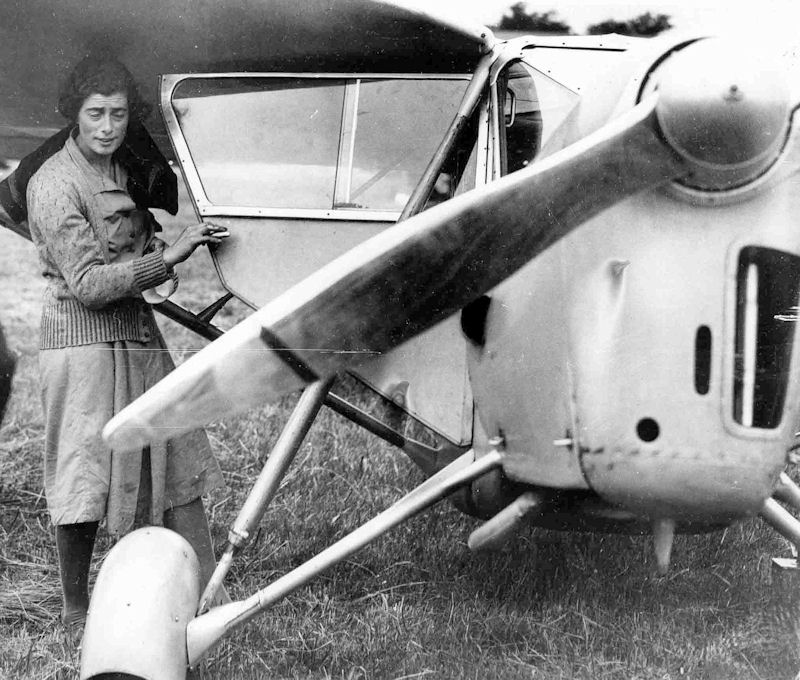
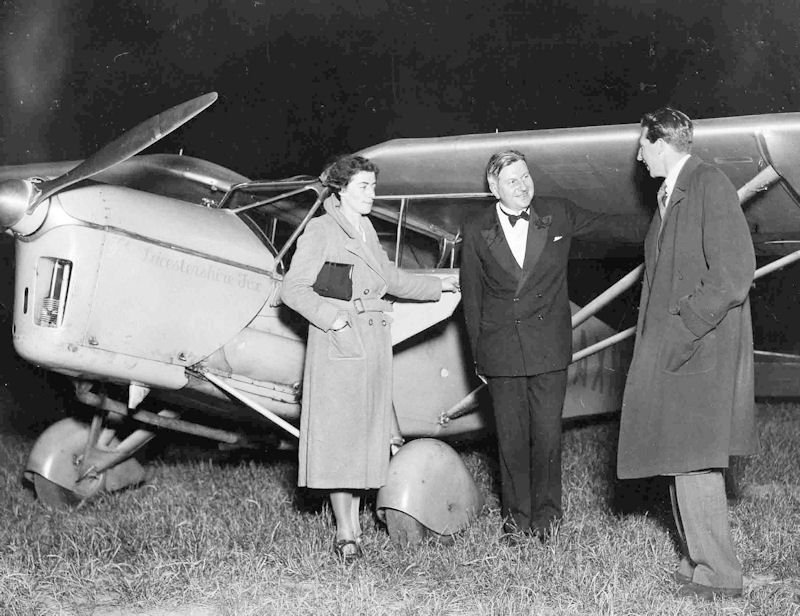
She was personal pilot to Leicestershire M.P. Lyndsey Everard from February 1931 - they are seen here with Nigel Norman.
And then, suddenly, on 13 January 1933, she was dead - not in an air crash, but as a result of a cold which rapidly worsened into pneumonia. Only few days before, in conversation with a friend, she had mentioned that her mother had died from influenza in 1918. "The deaths of both mother and daughter occurred with the same suddenness."
They are buried together in Hinton Parva: see http://www.earlyaviators.com/espoone5.htm
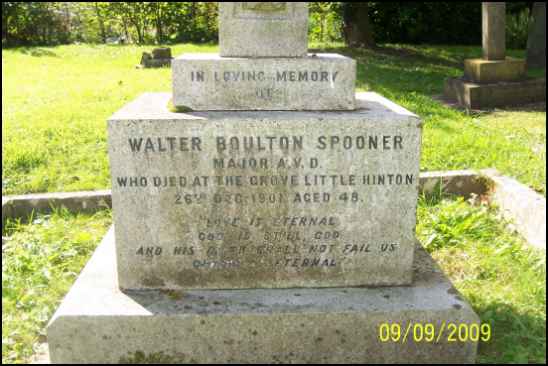
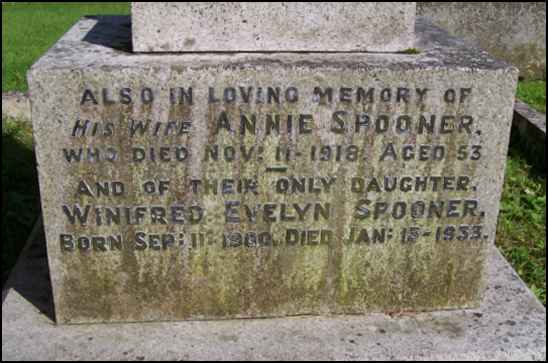
She left £1,357 0s 8d, and her brother, Capt. Frank Vivian Spooner, Indian Army (retd) was appointed administrator. She hadn't got round to writing a will.
There is a scholarship in her memory at Sherborne School for Girls.
"In the passing of Winifred Spooner the world has lost a great woman... she stood out as a woman of indomitable courage".
Winifred owned:
a 1926 DH.60 Moth (G-EBOT),
a 1928 DH.60G Gipsy Moth (G-AAAL, which she sold to Elise Battye);
a 1930 Desoutter IID (G-ABCU - this is the aeroplane she and E.C.T. Edwards ditched in the sea off Naples in December 1930), and later
a 1932 Breda 33 (G-ABXK), which was sold in Italy just 3 months before her death.
Winifred's brother Tony was chief flying instructor at the Montreal Flying Club in 1931. He was killed in March 1935 in Egypt when piloting a D.H. 84 Dragon, SU-ABI belonging to Misr Airwork, when it was caught up in a sandstorm and both engines failed.
-
Stack, Thomas Neville
Capt Thomas Neville Stack 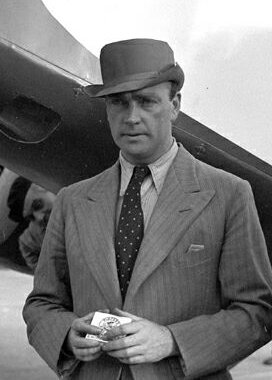 1934, aged 38
1934, aged 38
RAeC [0312-0087]
b. 1 April 1896; universally known as 'Stacko'
RFC in WWI, then became a familiar figure in aviation circles during the 1920s - in 1926 he and Bernard Leete made the first flight from England to India in two DH. Moths, one of several record-breaking flights.
He and J R Chaplin tried to fly to Australia and back in 1931, but had to turn back at Constantinople, Turkey, with carburettor trouble; later in the year the same pair attempted a flight to India and back, but again turned back with mechanical problems.
He was appointed 'Air Superintendent' of Iraq Airwork Ltd in 1933, and flew their first machine (a Spartan Cruiser) there via Cairo in 1933. Shortly afterwards, he flew 2 doctors and a nurse out to India, to perform an urgent operation on a Nepalese princess.
Late 1933 found him testing the Airspeed Courier - which is probably where he met Sydney Turner - and was widely expected to fly it in the MacRobertson Race. A month before the race, he broke (his own) London-Copenhagen record in a Miles Hawk, which is perhaps why he was too busy to inspect the Viceroy properly....
He turned up for the MacRobertson Race looking very tired and drawn - Alan Goodfellow described him as looking 'over-trained, physically', and Neville Shute Norway said he was "an exhausted and a worried man".
Shortly after the race, he was appointed Air Superintendent and Manager of Hillman's Airways; after that became part of British Airways he spent time in Turkey, advising them on civil aviation.
He was killed when run over by a lorry in Karachi, India on 22nd February 1949, aged 52. At first, the Karachi Police said he had committed suicide but, while agreeing that he was 'on the verge of a nervous breakdown', the inquiry decided that the cause of death was actually an aneurism of the aorta, and he would have died anyway.
Neville was "always very good company. He was never happier than when singing a song and strumming on his banjo."
-
Staniland, Christopher Stainbank
Flt-Lt Christopher Stainbank Staniland 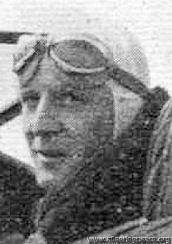 1938
1938A Schneider Trophy pilot, in 1928.
Fairey's chief test pilot from 1936; 'His real love is motor racing' (well, thanks very much). bailed out from the same aircraft twice in one day.
Killed in WWII: 26 June 1942 in a Fairey Firefly; buried Keddington, Lincs.
-
Summers, Joseph
F/O Joseph 'Mutt' Summers 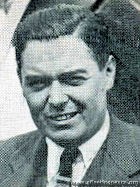 1930, aged 26
1930, aged 26'Mutt' Summers, chief test pilot for Vickers and Supermarine. Flew the Spitfire prototype on its first flight. Called 'Mutt' because he liked to pee on or near his aeroplane before taking off; is that too much detail?
Still has the most flying hours of any test pilot in the world.
d. 1954.
-
Thorne, G
F/O G Thorne ?? -
Trench, Charles Frederick Le Poer
Flt-Lt Charles Frederick Le Poer Trench 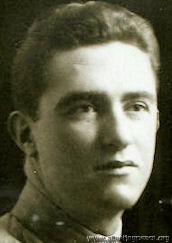
photo: 1917, when 2nd Lieut in the RFC, aged 22
An Australian who was a SPAD pilot in WWI; died in Sydney in 1974. -
Wallace, Alexander Frew
Mr Alexander Frew Wallace 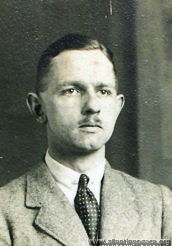 1927, when a medical student, aged 28
1927, when a medical student, aged 28from Kalmalcolm, Scotland
-
Wheeler, Allen Henry
Mr Allen Henry Wheeler CBE MA 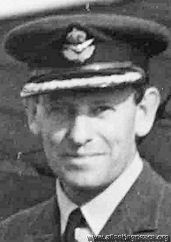 1948, aged 46
1948, aged 46b. 27 Sep 1903, Bitterley, Ludlow
Ed. Eton, University of Cambridge
RAF 1925-55: RAF Officer (Engineering); at Boscombe Down and Farnborough during WWII
Trustee, Richard Ormonde Shuttleworth Remembrance Trust, Old Warden, Beds, from 1947 to 1980
4th place in the Kemsley Challenge Trophy, Birmingham, 31 Jul 1949
1 of 3 assessors, BOAC DH106 Comets G-ALYP & G-ALYY Accident Enquiry, Ministry of Transport & Civil Aviation, 19 Oct to 24 Nov 1954
Wrote ' That Nothing Failed Them' (1963), 'Building Aeroplanes for those Magnificent Men' (1965), and 'Flying Between the Wars' (1972)
Aviation Consultant and Technical Advisor to the film industry, including 'Those Magnificent Men in their Flying Machines' (1965) and 'The Blue Max' (1966)
Member of GAPAN, 22 Sep 1966
President of RAeS Bedford Branch (FRAeS), 1977-78
d 1 Jan 1984 - Whistley Bridge, Berks
Research: thanks to Steve Brew
Page 2 of 2

